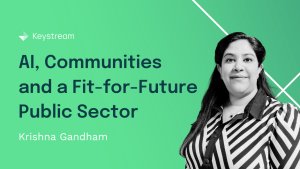15.09.2025
From Perfectly Choreographed Groceries to Well-Orchestrated Public Services: What We Learned from a Leading UK Supermarket
As part of our work exploring how operational design principles translate across sectors, we recently visited one of the UK’s leading supermarket micro-fulfilment centres (MFC). We were curious to see how one of the country’s most complex logistics operations balances automation, efficiency and human input to meet high-volume demand.
On the surface, it seems far removed from public service delivery. Yet the parallels are clear. This supermarket has taken a complex challenge — meeting customer demand quickly and efficiently — and built a system that is ruthlessly optimised, data-driven and relentlessly customer-focused.
What impressed us about the supermarket
Several themes stood out during the visit:
-
Visibility and data: every product is tracked from entry to exit, creating a level of transparency that enables smarter decisions at every stage.
-
Efficiency and flow: operations are built to seamlessly flow from end-to-end. Every process is trialled, improved and optimised to deliver at speed and scale. It is a model of continuous improvement.
-
Balancing humans and machines: automation is applied where it genuinely adds value, while people remain essential for flexibility and human judgement.
-
Integration: digital and operational teams work together seamlessly, ensuring the system is not just efficient but resilient.
-
Customer-first thinking: every innovation is designed with the end-user in mind, from speed of delivery to the reliability of service.
A visit to the MFC revealed machines moving in perfect harmony — rising, gliding and lowering with precision. Each box arriving exactly when and where it was needed. It felt like a choreographed dance, flawlessly executed by technology and people working together. Behind the shelves was a system built with clear purpose: to get products to customers quickly, reliably and efficiently.
Watching this in action, it raises the question: what if we applied the same principles to public services?
Where the public sector can learn
There are several areas where lessons resonate with public service challenges:
-
Healthcare: bed management, theatre scheduling, outpatient processes, waiting lists, patient-initiated follow ups and even mental health pathways could all benefit from supermarket-style flow and data-driven visibility.
-
Local government and community services: from asylum accommodation matching to transport coordination and long-term care, there are opportunities to apply modular, data-first thinking to improve outcomes for individuals and families.
-
Operations across the board: centralised booking teams, better integration of digital and operations, and redeploying staff to more complex tasks while using automation for routine work could all help services become more responsive and efficient.
Reflection
The supermarket model shows us that transformation does not always require revolutionary technology. Often, it starts with design discipline, iterative improvement and openness to change. By focusing on flow, making better use of data and blending automation with human expertise, public services could create systems that are leaner, more resilient and above all, more people-focused.
If a supermarket can choreograph groceries to every postcode, surely we can orchestrate vital services so they reach the people who need them most.
Big transformation often starts with small, smart shifts. This model shows what’s possible, and whether it’s groceries or government, nationwide delivery or national health, Keystream’s goal is to demonstrate that every little improvement helps.

